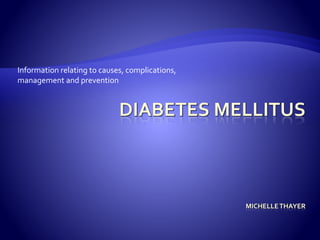
Diabetes Mellitus
- 1. Information relating to causes, complications, management and prevention
- 2. More commonly know as diabetes, it is a metabolic disease with no cure. Everything we eat is converted to glucose (sugar) and is used by our cells for energy. The pancreas produces insulin, the hormone responsible for controlling glucose. If the pancreas is “malfunctioning”, the insulin level will be insufficient and the glucose will not move to the body’s cells, but will build up in the blood instead. Diabetes is a result of these high glucose levels in the blood.
- 3. There are 3 main types of diabetes: • Type I • Type II • Gestational
- 4. • Pancreas produces no insulin due to destruction of the pancreatic beta cells • Insulin dependent • Previously known as “juvenile diabetes” • Major risk factor is genetics • Most common in the white population
- 5. • The pancreas doesn’t produce enough insulin or the cells are insulin resistant • Controlled through diet, exercise and sometimes oral medication • Genetics and obesity are major risk factors • Type II diabetes is more common in African Americans, Latinos, Native Americans, and Asian Americans, as well as the older population.
- 6. • Develops during pregnancy due to changes in the hormones • Pre-pregnancy weight may be a factor • Moderate risk of developing type II later in life • Patient’s age during pregnancy may determine the child’s risk factor
- 7. • Unexplained weight loss or gain • Slow healing wounds • Unusual fatigue and/or irritability • Sleeplessness • Frequent urination • Excessive thirst • Recurring infections (skin, bladder, vaginal) • Blurry vision • By the time symptoms are evident, damage may have already been done to the kidneys, cardiovascular system or eyes.
- 8. Diabetes can only be diagnosed by a medical doctor. A fasting blood glucose test will be performed. Normal results are levels less the 100 mg/dl. If the reading is above 126, the physician may order a second test in a few days. If a second reading is above 126, the patient is determined to have diabetes. If one test is normal, and the other is high, the patient is considered to have “impaired glucose intolerance” and is considered a high risk for developing diabetes
- 9. Nephropathy (kidney disease; may lead to kidney transplant or dialysis) Atherosclerosis (hardening of the arteries due to plaque build- up; increases the risk of a stroke) Gangrene (wounds that won’t heal; can lead to extremity amputation) Hypoglycemia (low blood sugar level; may cause seizures, coma, death) Neuropathy (limited blood flow to the nerves, possibly causing death of the nerves) Ketoacidosis (fat and protein release into the urine; may cause dehydration, shock, coma, death) Vision (retinopathy, glaucoma, cataracts)
- 10. The blood vessels in the retina are weakened causing tiny bulges called microanuerysms to protrude from the walls. Patients will need to have laser treatments performed on their eye by an Ophthalmologist
- 11. A photo of an eye that has had laser treatment to stop the blood leakage. Each “spot” on the eye is now scarred, and vision is permanently impaired.
- 12. If you are a man with type 1 diabetes, the odds of your child getting diabetes are 1 in 17. If you are a woman with type 1 diabetes and your child was born before you were 25, your child's risk is 1 in 25; if your child was born after you turned 25, your child's risk is 1 in 100. If both parents have type 1 diabetes, the risk is between 1 in 10 and 1 in 4. If both parents have type 2 diabetes, the child's risk is about 1 in 2. Identical twins have identical genes. However, research has shown that when one twin has type I diabetes, the other twin develops the disease about 50% of the time. When one twin has type 2 diabetes, the other twin will develop the disease approximately 75% of the time. Data retrieved from the American Diabetes Association
- 13. Exercise -get active and stay active by doing things you enjoy, from gardening to walking with friends. Daily monitoring of glucose levels Regular medical checkups. Early detection and management is vital to your body’s systems. Limit the use of alcohol Maintain a healthy diet by increasing fiber, eating vegetables and fruits daily, and reducing sweets Diabetics should have their A1C checked twice per year. A1C is a blood test that measures a patient’s average blood glucose control for the past 2 to 3 months.This test is becoming “the new standard” for diagnosing diabetes